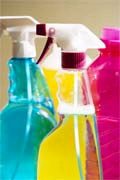Multifaceted Approach to Assess Indoor Environmental Quality
Posted on by- Of new-onset asthma cases in adults, 15–23% are work-related asthma [American Thoracic Society 2004]
- The highest percentage of work-related asthma occurred among operators, fabricators, and laborers (32.9%) [Worker Health Chartbook 2004]
- Between 35 and 60 million of the 89 million indoor environment workers have building-related symptoms of eye, nose, and throat irritations or headache and fatigue [Mendell 2002]
The indoor environment has changed. Materials emitting high formaldehyde levels are being eliminated from indoor environments. However, many questions remain regarding occupational asthma and work-exacerbated asthma and the indoor environment. What are the irritants/sensitizers that cause these diseases? Can they be controlled? What is the actual physiological mechanism? What are the actual exposures in the workplace? There is probably no single one chemical exposure responsible for these illnesses, but more likely a mixed exposure of chemical classes such as particulate matter and oxygenated organic species (oxidized volatile organic compounds that are likely biologically reactive and potentially cause cell damage and increase susceptibility to disease).
The possible answers to these questions might be found in investigating the chemistry of volatile organic compounds found in the indoor environment, developing new sampling methods, and improving assessments of chemical health effects. Consumer products used in indoor environments for cleaning, surface finishing and deodorizing are typically mixtures of many chemicals. Some of these are volatile organic compounds, meaning they evaporate into the air, and others are non-volatile, meaning they adhere to the surface. There are additional reactants in the indoor environment which can facilitate the oxidation of these consumer products. The recent emphasis on “natural” or “green” cleaning products has led to an increase in the use of terpenes (hydrocarbons produced by plants—particularly conifers) like alpha-pinene, limonene and delta-carene in cleaners and air fresheners. However, natural does not always mean safe. Terpenes can react with components in the indoor environment to form new chemicals that might be the irritants responsible for the observed increases in work-related asthma. Many of these oxidation products are not captured by conventional sampling methods, leading some researchers to suspect that workers who are exposed to oxidized chemicals may not know it.
To address this research question, the National Institute for Occupational Safety and Health (NIOSH) has developed expertise in investigating the fundamental chemistry of several chemicals in consumer products that may be used in an indoor environment. These investigative efforts have produced many important insights into a chemical’s fate in the indoor environment, possible new sampling techniques and identification of chemical structures that could lead to health effects.1,2,3,4,5,6
Indoor reactions are initiated mainly by ozone, a pollutant, which is transported from the outdoor environment into the indoor environment by building ventilation. NIOSH research has shown that when combined with ozone, one of the common components of pine oil cleaners, alpha-terpineol, transforms into many oxygenated organic compounds in both the gas-phase and on surface reactions creating new products potentially harmful to those exposed. Similar reactions were observed with many of the terpenes investigated.
Given that these new oxygenated species are not detected by conventional sampling methods, new techniques are needed to assess worker exposure and the potential health risk. These reaction products need to be stabilized to survive the conditions necessary for analysis. NIOSH is working to modify the current stabilization technique so that it can be used by industrial hygienists in the field.
Once we have a better understanding of the exposures created by these products we can work to better understand the health effects caused by indoor pollution. Recent research has shown that products created by these reactions could be sensitizers and irritants contributing to the health effects of those exposed. Additional research is needed to confirm these findings. As we move forward, the following questions continue to motivate this research:
- What are the chemical structures that comprise “missing” or undetected carbon?
- How are the reaction products partitioned in gas phase or particulate phase?
- Does exposure to mixtures of different oxygenated organic compound structures result in disease “greater” than the sum of the parts, i.e., do the reaction products combine to result in a more “toxic” mixture?
Dr. Wells is Team Leader of the Gas and Vapor Team in the Exposure Assessment Branch in the NIOSH Health Effects Laboratory Division.
References
- Anderson, S. E.; Wells, J. R.; Fedorowicz, A.; Butterworth, L. F.; Meade, B. J.; Munson, A. E. Evaluation of the contact and respiratory sensitization potential of volatile organic compounds generated by simulated indoor air chemistry. Toxicological Sciences 2007, 97, 355-363.
- Wells, J. R. Gas-phase chemistry of alpha-terpineol with ozone and OH radical: Rate constants and products. Environmental Science & Technology 2005, 39, 6937-6943.
- Weschler, C. J.; Wells, J. R.; Poppendieck, D.; Hubbard, H.; Pearce, T. A. Workgroup report: Indoor chemistry and health. Environmental Health Perspectives 2006, 114, 442-446.
- Forester, C. D.; Ham, J. E.; Wells, J. R. Geraniol (2,6-dimethyl-2,6-octadien-8-ol) reactions with ozone and OH radical: Rate constants and gas-phase products. Atmospheric Environment 2007, 41, 1188-1199.
- Ham, J. E.; Wells, J. R. Surface chemistry reactions of alpha-terpineol [(R)-2-(4-methyl-3-cyclohexenyl)isopropanol] with ozone and air on a glass and a vinyl tile. Indoor Air 2008, 18, 394-407.
- Pacolay, B. D.; Ham, J. E.; Slaven, J. E.; Wells, J. R. Feasibility of detection and quantification of gas-phase carbonyls in indoor environments using PFBHA derivatization and solid-phase microextraction (SPME). Journal of Environmental Monitoring 2008, 10, 853-860.
Posted on by


